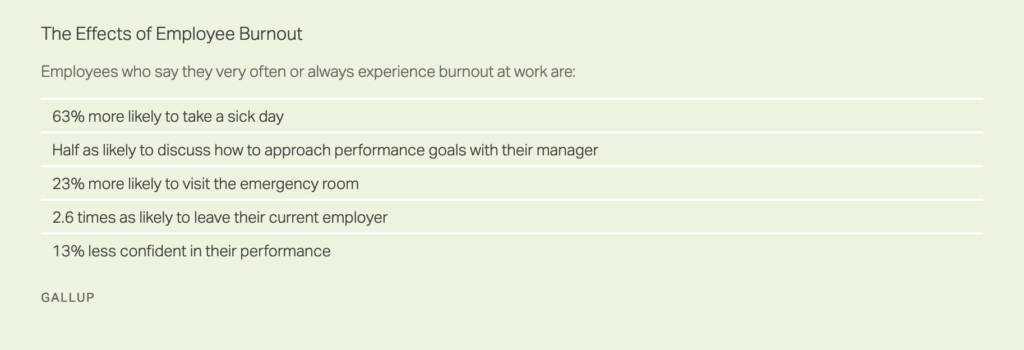April 16, 2024
HR Teams and Managers’ Guide to Leave Planning
An efficient leave planning process is vital if you want to allow your employees to take time off without cau...

Employee burnout can cause serious damage to your company, and more importantly to the lives of honest, hard-working employees.
It’s serious enough that the World Health Organization (WHO) recognizes it, classifying it as an “occupational phenomenon” and a threat to well-being in the workplace.
If you’re a business owner, manager, or in any way leading a team, you need to know about burnout and the effect it has. In this article we’ll share with you everything you need to know to manage burnout in your organization, and more importantly, to prevent employee burnout in the first place.
Burnout is a state of exhaustion brought on by stress, usually to do with overwork or problems at work. It can show in a number of ways, including physical or mental symptoms.
The WHO’s definition mentions three dimensions to workplace burnout:
Many studies and surveys have been conducted that look at how widespread job burnout is.
In one study, Asana found that 70% of the more than 10,000 knowledge workers participating in the study experienced burnout at some time in the last year.
In a Gallup study, 67% of the 7500 employees surveyed reported feeling burned out at least some of the time – 23% saying they experience burnout at work very often or always.

In another, Deloitte conducted a study of 1,000 full-time workers in the US, and 77% said they had experienced burnout in their current job, more than half saying they had experienced burnout more than once.
These are just a few examples of the research that has been done into worker burnout, and gives you some idea of how common and widespread the issue is today.
Burnout gets progressively harder to treat the longer it’s left unchecked, and recognizing the signs of employee burnout is essential for catching it early.
Here are some of the most common signs of burnout:
These signs do not always indicate a clear-cut case of job burnout, but should be cause for further investigation as to whether further action is needed to help the employee.
Read More: The Importance of Mental Health Days in the Workplace
The WHO’s definition of burnout states that it is a “syndrome conceptualized as resulting from chronic workplace stress that has not been successfully managed.”
This is good as a broad description of where burnout comes from, but to manage and prevent burnout effectively, you’ll need to understand it on a deeper level.
There are always more precise things that lead to an increase in employee stress, which is then not effectively managed, and grows into burnout.
Here are some of the most common causes:
Further Reading: the 5 Stages of Employee Burnout.
When it comes to addressing burnout, prevention is always much easier than trying to find a cure. And the longer an employee has been burned out, the more difficult it is to turn it around.
You can help employees manage burnout by first noticing the early signs of burnout, and then taking the following steps (where appropriate/necessary):
The first thing to do is talk with the person, and hear what they have to say about what they’re feeling/experiencing. Sometimes a talk will be enough in itself to improve things, but making employees feel supported and valued. But it should also bring forth the reason they have become burned out, which lets you craft your next steps.
Hopefully, a conversion will unearth the root cause of burnout. From there, take action to fix the issue, such as reducing their workload, helping employees maintain a better work-life balance, or addressing interpersonal problems in the workplace.
Whatever the cause, a vacation is a great way to help employees manage stress, recharge, and reduce burnout. Even just a few days off can help. Just make sure the person feels free to completely switch off work while they’re away, and is not going to come back to a bigger mountain of work when they return.
You may want to make changes to your work environment. If you have a high-pressure, low-reward work culture, don’t be surprised by high levels of employee burnout.
And if you unearth any personal issues within the workplace, such as office politics, bullying or harassment, stamp these out as soon as possible.
If things are really bad, the employee may be advised to get help from a mental health professional. Support your employees if this is the case; try to eliminate stigma of people seeking help for their mental health, and don’t look down on someone for admitting that they need help.
Learn More: The benefits of a Mandatory Vacation Policy, and examples of well-known companies that use this approach to vacation time.
As mentioned, the best way to combat burnout is to prevent it, rather than wait and treat employee burnout after the fact.
Preventing employee burnout comes down to building a positive, wellness-centric work environment. Here are some tips for building a burnout-free workplace:
Employee burnout is a serious concern; left unchecked, it will lead to increased rates of employee turnover, poor productivity, and interpersonal issues in your workplace.
It’s even worse for the employee. Workplace stress carries over into someone’s personal life, generating mental health issues, physical health problems, general unhappiness and personal problems at home.
It’s your responsibility, as the leader of a team of people, to help promote employee engagement, happiness, satisfaction, and let employees work in a positive environment, free from burnout.
Reducing or preventing employee burnout will result in a happier, more productive team, a more successful company and more fulfilled lives for your team members.
Flamingo makes managing your team’s paid time off a breeze.